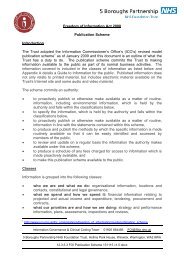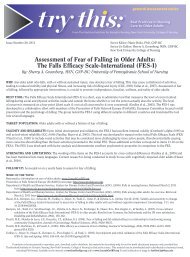5 Boroughs Partnership NHS Foundation Trust Annual ... - Monitor
5 Boroughs Partnership NHS Foundation Trust Annual ... - Monitor
5 Boroughs Partnership NHS Foundation Trust Annual ... - Monitor
Create successful ePaper yourself
Turn your PDF publications into a flip-book with our unique Google optimized e-Paper software.
230<br />
27. Financial risk management continued.<br />
Also, financial instruments play a much more limited role in creating or<br />
changing risk than would be typical of listed companies to which the financial<br />
reporting standards mainly apply. The <strong>NHS</strong> <strong>Trust</strong> has limited powers to borrow<br />
or invest surplus funds and financial assets and liabilities are generated by dayto-day<br />
operational activities rather than being held to change the risks facing<br />
the <strong>NHS</strong> <strong>Trust</strong> in undertaking its activities.<br />
The <strong>Trust</strong>’s treasury management operations are carried out by the Finance<br />
department, within parameters defined formally within the <strong>Trust</strong>’s standing<br />
financial instructions and policies agreed by the Board of Directors. <strong>Trust</strong><br />
treasury activity is subject to review by the <strong>Trust</strong>’s internal auditors.<br />
Currency risk<br />
The <strong>Trust</strong> is principally a domestic organisation with the great majority of<br />
transactions, assets and liabilities being in the UK and sterling based. The <strong>Trust</strong><br />
has no overseas operations. The <strong>Trust</strong> therefore has low exposure to currency<br />
rate fluctuations.<br />
Interest rate risk<br />
The <strong>Trust</strong> currently has no borrowing. The <strong>Trust</strong> therefore has no exposure to<br />
interest rate fluctuations.<br />
Credit risk<br />
Because the majority of the <strong>Trust</strong>’s income comes from contracts with other<br />
public sector bodies, the trust has low exposure to credit risk. The maximum<br />
exposures as at 31 March 2012 are in receivables from customers as disclosed<br />
in the Trade and other receivables note.<br />
Liquidity<br />
The <strong>Trust</strong>’s operating costs are incurred under contracts with primary care<br />
trusts, which are financed from resources voted annually by Parliament. The<br />
<strong>Trust</strong> funds its capital expenditure from funds obtained within its Prudential<br />
Borrowing Limit. The <strong>Trust</strong> is not, therefore, exposed to significant liquidity<br />
risks.<br />
28. Prudential Borrowing Limit<br />
The <strong>Trust</strong> is required to comply with and remain within a prudential borrowing<br />
limit.<br />
This is made up of two elements:<br />
The maximum cumulative amount of long-term borrowing. This is set by<br />
reference to the four ratio tests set out in <strong>Monitor</strong>'s Prudential Borrowing<br />
Code. The financial risk rating set under <strong>Monitor</strong>'s Compliance Framework<br />
determines one of the ratios and can therefore impact upon the long-term<br />
borrowing limit; and<br />
The amount of any working capital facility approved by <strong>Monitor</strong>.<br />
<strong>Annual</strong> Report and <strong>Annual</strong> Accounts 2011-12








